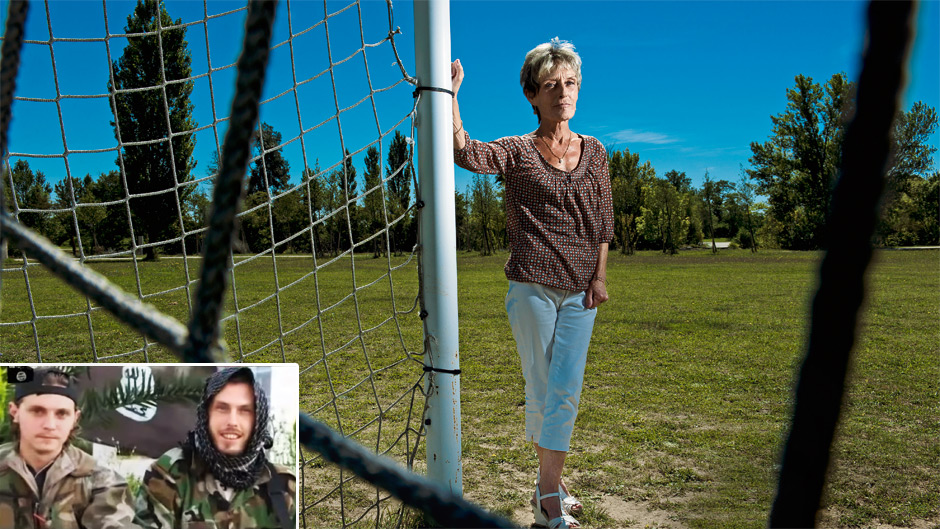How to lose a child to terror
More than 2,000 young Europeans have joined jihadist groups from the Middle East. They are good pupils from good families who are now picking up guns and carrying out attacks

“To Nicolas´s father and mother. Your son carried out an explosive operation with a truck in the enemy village of Homs. May God accept him as a martyr.” This message, written in French, was sent to Dominique Bons, 60, last December. Only five months before, she was taken by surprise on seeing her son Nicolas, 30, in an Internet video in which he claimed to be a member of the Islamic State terrorist group. He was known as a quiet boy who had played football as a forward, liked to go out on his bike and took good care of his 88-year-old grandmother. Nicolas began to study the Koran on his own and converted in 2010. His mother, who lives in Toulouse, in the south of France, is an atheist and occasionally spoke to her son about religion. “He told me he wanted a virgin. I said this would difficult to find nowadays,” said Dominique, a retired member of the military. As time went by, he stopped smoking marijuana. In March 2013, he and his half-brother, Jean Daniel, 22, told their parents they were going on holiday to Thailand. They never came back. Jean Daniel died in a battle near the Syrian city of Aleppo four months before Nicolas blew himself up in an attack in Homs. “I have seen no proof that my son died. I hope this is all a lie,” the mother said. In three years of civil war, more than 2,000 Europeans have joined terrorists groups in Syria, including the Al Nusra Front and the Islamic State which want to create a caliphate without borders ruled by Islamic law. This aim is leading them to turn thousands of girls into slaves, exterminate minority religious groups, extort the population of cities and cut the throats of those they regard as unbelievers or apostates. Last week a hooded jihadist with an English accent used a knife to decapitate Steven Sotloff, the second American journalist killed in two weeks. Both scenes were posted on the Internet. In France alone, around 700 young people have joined the perpetrators of this barbaric behavior.
What leads adolescents of 15 or over to take a train or plane, hide themselves from their families and start leading a radical life somewhere in the Middle East is an enigma that is beginning to be unveiled. The easy explanation that they are the children of Moslem immigrants who have found it difficult to assimilate into the Western world does not apply to them. Many come from good families which have been living in Europe for many generations and benefited from the advantages of the First World, such as free schools and hospitals. “Among 500 profiles we studied, we saw that they were all good students. They do not have the same poorly educated profile of those who would join Al Qaeda five years ago,” said Mathieu Guidère, a specialist in geopolitics and Islam at the University of Toulouse. Like other young people, they have the desire to change the world. The boys are usually more religious and nourish this desire for change more strongly. The girls are younger and want to support the men by creating families. At one point, they all end up being used by the extremists who help them become radical and then attract them into a trap abroad.
Some years ago, the extremists entered into contact with the European candidates through mosques. This service is currently being carried out through the Internet on a much greater scale. The terrorists organize competitions with prizes through Facebook. The girls need to publicize a religious message and accumulate the greatest number of “thumbs up”. The prize for the champion is usually a jilbab, a long dress with long sleeves. The organizers then congratulate the finalists and gain their trust. They then began to give them advice on their personal life and sow seeds in the families. They say that their parents do not look after them well and are unbelievers as they do not practice Islam the way they should. “At this time, they begin to think about marrying a militant and then decide to do so,” said an employee from the Sectarian Prevention Center Related to Islam, in France who requested anonymity.
Sarah Ali Mehenni, a 17-year-old French girl, received a jilbab through the post in her home in Lézignan-Corbières, 200 kilometers south from Avignon, one day. She is the daughter of a Frenchman of Algerian origin who is a non-practicing Moslem, and Severine who had never joined Islam. The girl decided to convert two years ago. Radicalization reached its peak in March when she left for Syria where she married a 35- year-old Tunisian. The oldest brother, Jonathan, 22, explained to Sarah that Islam prohibited marriage without the consent of the parents but she became upset. “She changed the interpretation of the text completely and does not listen to anything we say,” said Jonathan. The family communicates with Sarah through an anonymous account she created on Facebook and occasionally by telephone via satellite. “She sends photos with her husband´s pickup truck and says he buys her Chanel perfume. She says that she is happy but I don´t believe her,” said Jonathan. Her mother, Severine, who has fallen into a state of depression since her daughter left, recalls that Sarah used to say she wanted to work with humanitarian aid in Syria. “She is not helping anybody,” said Severine.
Most of these young people have the “humanitarian syndrome”. They become interested in the Middle East after seeing news about the deaths of women and children in Syria. Researching the subject brings them into contact with extremists and they lose their ability to make a logical interpretation of the issue. Instead of keeping a distance from the terrorists, they join them. As the Internet has no frontiers, the terrorists find supporters in all countries. One in every four is a foreigner. The group has become more flexible in order to increase its power of attraction. The Islamic State does not require the new member to know the Koran by heart but proposes teaching it along with military techniques. Islamic sharia law is gradually applied to the newcomers.
“This was the most international place I have ever been in my life. I saw Americans, Chinese and Koreans. I heard people talking Portuguese but I didn´t know whether they were Brazilians,” said Foad el Bathy, 37, who made two trips to Syria to try and rescue his 16-year-old sister, Nora, this year. Nora joined the Nusra Front which is linked to Al Qaeda. In the half an hour he spent with her, he saw that she was thin and pale and they cried a lot. Foad asked if she wanted to go back. Nora hit her head against the wall, repeating: “I can´t, I can´t”. He believes they had threatened to kill him if she accepted his offer to leave. Nora fled her home in Avignon in the south of France in January. She liked to watch the Disney Channel and American series and went out with her friends to the shopping mall. Now she speaks with the family in rare telephone calls. Nora cannot return but another 200 who have regretted making their trips have managed to do so. The most dangerous, however, are those who returned and have not repented and could commit attacks in Europe. Politicians in France and the UK began discussing this year the possibility of retaining the passports of jihadists to prevent them going to the epicenter of the terror. “It is very complicated to do something like that. Nobody can be imprisoned in a democracy for having radical ideas. Retaining a passport without concrete proof or limiting access to information is difficult,” said Italian political scientist Lorenzo Vidino from the University of Zurich.


 SEGUIR
SEGUIR
 SEGUINDO
SEGUINDO


 Tom pastoral de Marcos Mion destoa da crítica de Madonna no palco
Tom pastoral de Marcos Mion destoa da crítica de Madonna no palco Temer é consultado sobre manobra que livraria Bolsonaro de eventual prisão
Temer é consultado sobre manobra que livraria Bolsonaro de eventual prisão Madonna esconde rótulo de cerveja, joga garrafa e patrocinador vira meme
Madonna esconde rótulo de cerveja, joga garrafa e patrocinador vira meme Madonna: participação ‘muda’ de Anitta teve motivo prévio
Madonna: participação ‘muda’ de Anitta teve motivo prévio A razão de William Bonner usar avião da FAB para ir ao Rio Grande do Sul
A razão de William Bonner usar avião da FAB para ir ao Rio Grande do Sul







